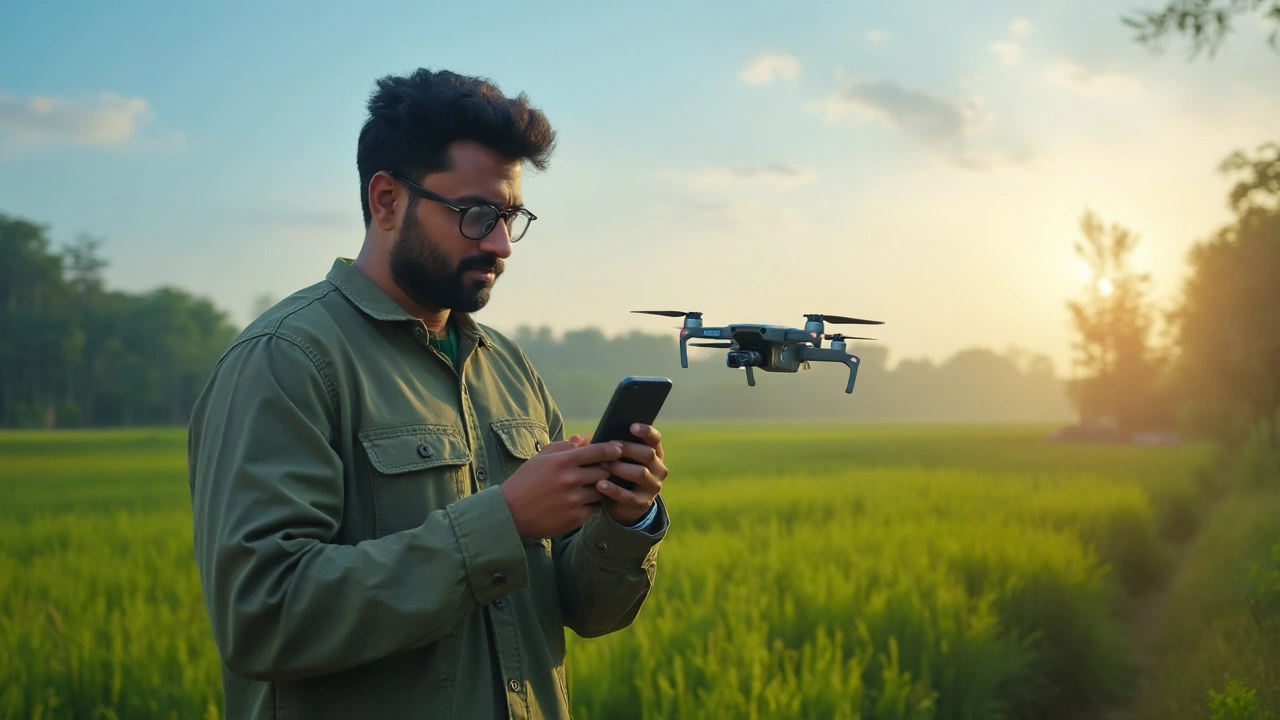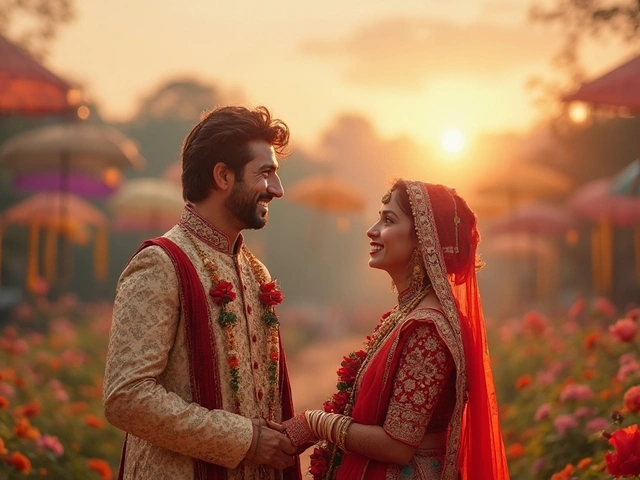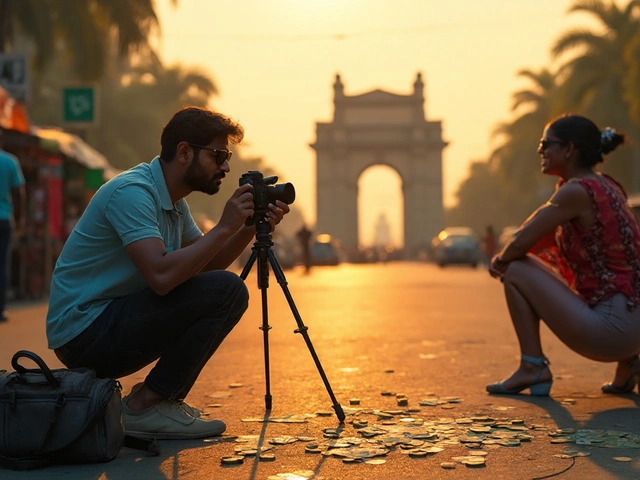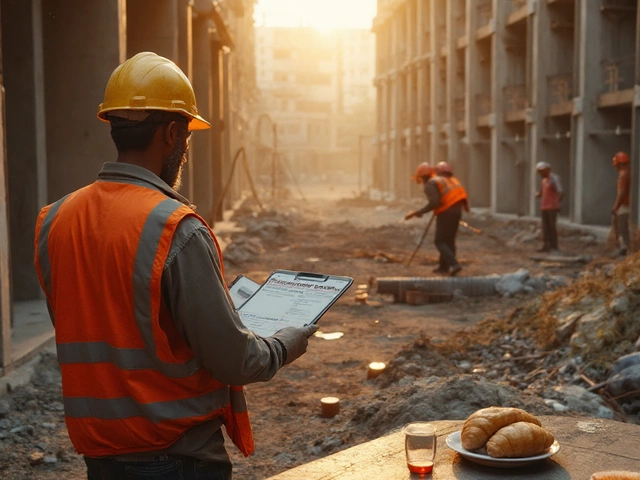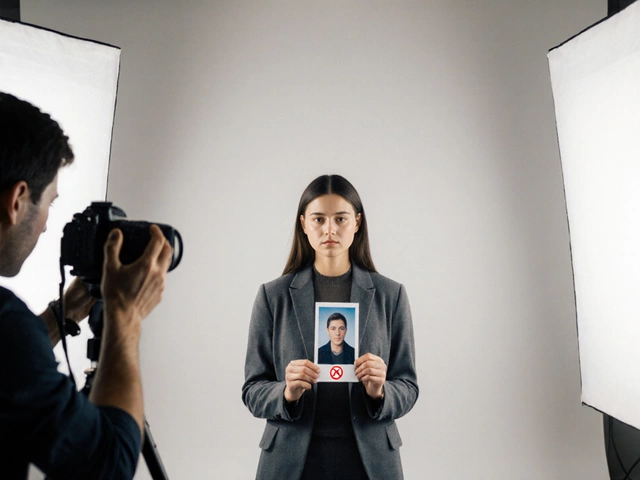Drones have revolutionized the world of photography, giving rise to a new dimension of aerial imagery that was once only accessible with aircraft. With the introduction of compact yet powerful drones like the DJI Mini 3 Pro, capturing stunning vistas from above is now easier and more cost-effective. However, as with many tech advancements, the legal framework governing their use can be complex, particularly in a diverse country like India.
If you're considering flying the DJI Mini 3 Pro in India, you might be wondering about the legal hoops one needs to jump through. This article aims to untangle the intricate web of drone regulations in India, focusing on whether a license is necessary for operating drones like the DJI Mini 3 Pro. Let's dive into the essentials, enabling drone enthusiasts to soar creatively without fret.
- Understanding Indian Drone Regulations
- Introducing the DJI Mini 3 Pro
- When is a Drone License Required?
- DJI Mini 3 Pro's Place in Indian Law
- Tips for Safe and Legal Drone Flying
- Future of Drone Usage in India
Understanding Indian Drone Regulations
Drones, affectionately known as Unmanned Aerial Vehicles (UAVs), have taken the globe by storm, capturing stunning landscapes and aiding in diverse activities like survey missions and disaster management. In India, the regulatory framework governing drones is primarily managed by the Directorate General of Civil Aviation (DGCA). This framework is designed to ensure safety and security in the skies while promoting the burgeoning field of drone photography India. The DGCA's policies are encapsulated in the 'Drone Rules, 2021', a comprehensive guide for drone enthusiasts and professionals alike.
The DGCA has categorized drones based on their weight into five distinct categories: Nano drones, which weigh up to 250 grams, Micro drones exceeding 250 grams but not exceeding 2 kilograms, Small drones over 2 kilograms but under 25 kilograms, Medium drones over 25 kilograms up to 150 kilograms, and Large drones over 150 kilograms. This classification determines the requirements for regulatory compliance, including registration, permissible flight zones, and the necessity for a UIN (Unique Identification Number) or UAS (Unmanned Aircraft System) Operator Permit.
One crucial aspect of these regulations is the mandate for 'No Permission, No Takeoff' (NPNT) compliance. This digital permission feature ensures that drones can only take off if granted clearance through a digital portal, ensuring secure integration into Indian airspace. For hobbyists flying DJI Mini 3 Pro, understanding this concept is pivotal to avoid unauthorized flights. It's interesting to note that India has color-coded airspace maps dividing the country into 'Red', 'Yellow', and 'Green' zones, indicating where drones can safely and lawfully operate.
The Influence of Tech Advancements
With rapid advancements in drone technology, the regulations are continuously evolving. Developments like collision avoidance systems, GPS integration, and improved battery life are not just making drones more efficient but are also shaping the rules. According to Amit Sinha, a renowned expert on UAV regulations, "The dynamic nature of drone technology makes it imperative for regulatory frameworks to be adaptive and forward-thinking." The DGCA holds regular consultations with stakeholders to ensure that the regulations are aligned with global practices, balancing innovation with safety concerns.
Statistical data shows that India is witnessing an exponential rise in drone operations. A report from 2023 noted a 40% increase in the number of drones registered with the DGCA within a year. This statistic underscores the growing acceptance and utility of drones in India. However, with increasing numbers also comes the need for enhanced safety protocols to prevent any intrusive or hazardous incidents.
Engaging with the drone community through workshops and seminars forms a significant part of the DGCA's efforts to educate potential and current drone operators. These sessions cover vital areas such as airspace safety, privacy concerns, and understanding the technological designs specific to models like the DJI Mini 3 Pro. By focusing on community engagement and continuous education, the regulatory body aims to foster responsible and innovative drone usage across the nation.
Introducing the DJI Mini 3 Pro
The DJI Mini 3 Pro is an impressive piece of technology that stands out in the world of aerial photography and cinematography. This compact drone is designed to be user-friendly while packing in powerful features that appeal to both novices and veteran drone operators. Weighing under 250 grams, the Mini 3 Pro is light enough to fit snugly into a backpack, yet it delivers stunningly high-quality imagery. Its camera is mounted on a three-axis gimbal, which ensures stable, crystal-clear video and sharp photos each time it takes to the skies. This model, being part of the renowned DJI Mini series, carries forward the tradition of excellence with its advanced obstacle sensing capabilities, making it an ideal choice for those new to drone flight or looking to enhance their current toolkit.
Key Features
The DJI Mini 3 Pro includes several cutting-edge features that distinguish it in the market. One of its hallmark capabilities is its 4K HDR video recording at 60 fps, allowing creators to capture cinematic scenes with vivid colors and stunning detail. Its true vertical shooting mode is perfect for social media enthusiasts who aim to create content that stands out on platforms like Instagram and TikTok. The drone's flight time is notably extended, clocking up to 34 minutes on a full charge, providing ample opportunity to get the perfect shot. Additionally, the Mini 3 Pro incorporates a trio of directional sensors—forward, backward, and downward—to avoid obstacles, adding a layer of safety that reassures pilots during complex maneuvers.
User Experience
The user experience with the DJI Mini 3 Pro is designed to be as seamless as possible. Everything from takeoff to landing can be managed through DJI's intuitive app, which includes automated functions such as QuickShots and MasterShots. These allow users to execute cinematic moves with the touch of a button, simplifying complex flight paths and camera angles. The mini drone also boasts an intelligent battery system and improved wind resistance compared to its predecessors, making high-altitude flights more stable and less daunting. For those passionate about night-time photography, the larger 1/1.3-inch sensor enhances low-light performance, unlocking creative potential under a sky full of stars.
Market Impact
Since its launch, the DJI Mini 3 Pro has garnered significant attention across the globe for its innovative features combined with an accessible price point. In a review by TechRadar, a notable tech publication, it has been described as "an impressive leap in technology for its size," underlining how it has set new standards in the sub-250g category of drones. This drone bridges the gap between professional grade and consumer-friendly, proving that high-end technology can indeed come in small packages. The ongoing advancements in drone technology as seen with the Mini 3 Pro suggest a burgeoning interest and investment in developing more agile, capable devices, serving diverse sectors from personal hobbyists to professional agencies.

When is a Drone License Required?
Flying drones has become a popular hobby and profession across the globe, and India is no different. However, this exciting trend brings an array of regulations to keep up with. In India, the laws for operating drones are governed by the Directorate General of Civil Aviation (DGCA), which defines specific categories for Remotely Piloted Aircraft Systems (RPAS). According to DGCA, drones are classified based on their weight, ranging from Nano drones, which weigh less than 250 grams, to Large drones, which weigh over 150 kilograms. For someone looking to fly the DJI Mini 3 Pro, a clear understanding of these classifications is essential for compliance and proper licensing.
The pivotal factor for determining whether a drone license is required is the weight of the drone and its intended use. Nano drones, like the DJI Mini 3 Pro when it is used strictly for non-commercial purposes, are generally exempt from licensing as long as they adhere to the basic operational guidelines set by the DGCA. These include flying below 50 feet and maintaining a line of sight. However, crossing into the Small category, which is 250 grams to 2 kilograms, requires drone operators to obtain Unmanned Aircraft Operator Permits (UAOP). Interestingly, permission could also be required if the operation involves flights over private properties, strategic locations, or beyond visual line of sight.
It's noteworthy that commercial use, regardless of drone size, mandates a UAOP, and obtaining this involves comprehensive steps. Operators need to register on the Digital Sky Platform, undergo security clearance from the Ministry of Home Affairs, and ensure the RPAS is equipped with essential features like the 'No Permission-No Takeoff' (NPNT) compliance. The government also insists on insurance for any third-party damage, emphasizing safety and accountability in its regulations. Industry experts often suggest beginners to engage with authorized training programs to better understand nuances in drone operations and avoid costly mistakes that could lead to penalties or legal actions.
"Drone laws in India are designed to promote safety, innovation, and accountability in the use of air space for civilian purposes," explains Ramesh Abhishek, a member of the Indian Drone Development Council.This approach aligns India’s drone regulatory framework with global standards, providing a balance between adopting cutting-edge technology and ensuring secure skies. The Digital Sky Platform is a noteworthy initiative by the DGCA, facilitating automated flying permissions, which promises to streamline the compliance process for licensed users. This can be specifically advantageous for the drone photography India sector, where prompt and professional service delivery is often crucial for a successful venture.
Whether you need a license also depends on the regions where you intend to fly. In restricted zones, permission from local authorities is often required, irrespective of the drone's size. This regulatory measure is in place to prevent interference with manned aviation and safeguard national security, a concern heightened given India's complex geopolitical landscape. Pilots who frequently fly in metropolitan areas or near airports should prioritize familiarizing themselves with ‘No-fly zones’ which are demarcated clearly on the Digital Sky Platform’s airspace map. Understanding these zones can prevent unintended airspace violations, which might otherwise lead to steep fines and confiscation of the drone.
DJI Mini 3 Pro's Place in Indian Law
In the vibrant world of drone photography in India, the DJI Mini 3 Pro has carved out a unique space, thanks to its state-of-the-art features packed into a lightweight design. Now, when it comes to navigating the labyrinth of drone regulations, one might think its compactness offers a free pass from licensing requirements. However, the reality necessitates understanding the specifics of Indian drone law, as outlined by the Director General of Civil Aviation (DGCA).
India categorizes drones into different classes based on their maximum take-off weight (MTOW), among which the DJI Mini 3 Pro typically falls under the Nano category, given its sub-250g weight. This is a significant factor, as drones below 250 grams usually do not require a license for recreational flying. Nonetheless, this aspect does not completely exempt amateur explorations from following crucial legal precedents. Drone operators must ensure they abide by the No Permission No Takeoff (NPNT) compliance unless explicitly exempted, a system the DGCA put forth to ensure accountability and safety in the skies over India.
Beyond weight, the operational intentions, i.e., whether flying for personal enjoyment or professional pursuits, also influence the legal stance. For instance, while no Remote Pilot License might be necessary for nano drones flown for fun in non-restricted zones, attention turns to registration under the Digital Sky platform, the gateway through which users file necessary flight permissions. Therefore, although the Mini 3 Pro sits neatly under the legal thresholds for tight regulations, any commercial photography endeavors might shift it into broader compliance requirements.
Implications for Commercial Use
For those eyeing the commercial road with the ">Mini 3 Pro, it's essential to examine the larger legal landscape. While the DGCA’s 2021 regulations provided a little relaxation, particularly for those under the Micro drone category and beyond, ensuring minimal disruption means aligning with the detailed requirements established specifically for professionals. It’s advisable to ensure every move from filing insurance for third-party liability to adhering to airspace segregation stipulations as defined.
The rules are simple: "No unauthorised flying, and safety remains the uncompromisable bedrock," says R. Chandramouli, an expert in India's UAV regulations. "While Mini 3 Pro pegs itself as consumer-friendly, awareness of where one flies, and the purpose is vital."
Understanding open and restricted zones is crucial. Engaging with the frequent updates on airspace maps released by Indian authorities ensures drone enthusiasts, like those using the DJI Mini 3 Pro, stay informed and compliant. The Digital Sky platform plays a pivotal role here, serving as an atlas and control center for aviation activities, ensuring every flight path is registered and legal. Smartly navigating this system paves the way for not just legality but pushing creative limits within the aerial photographic realm.
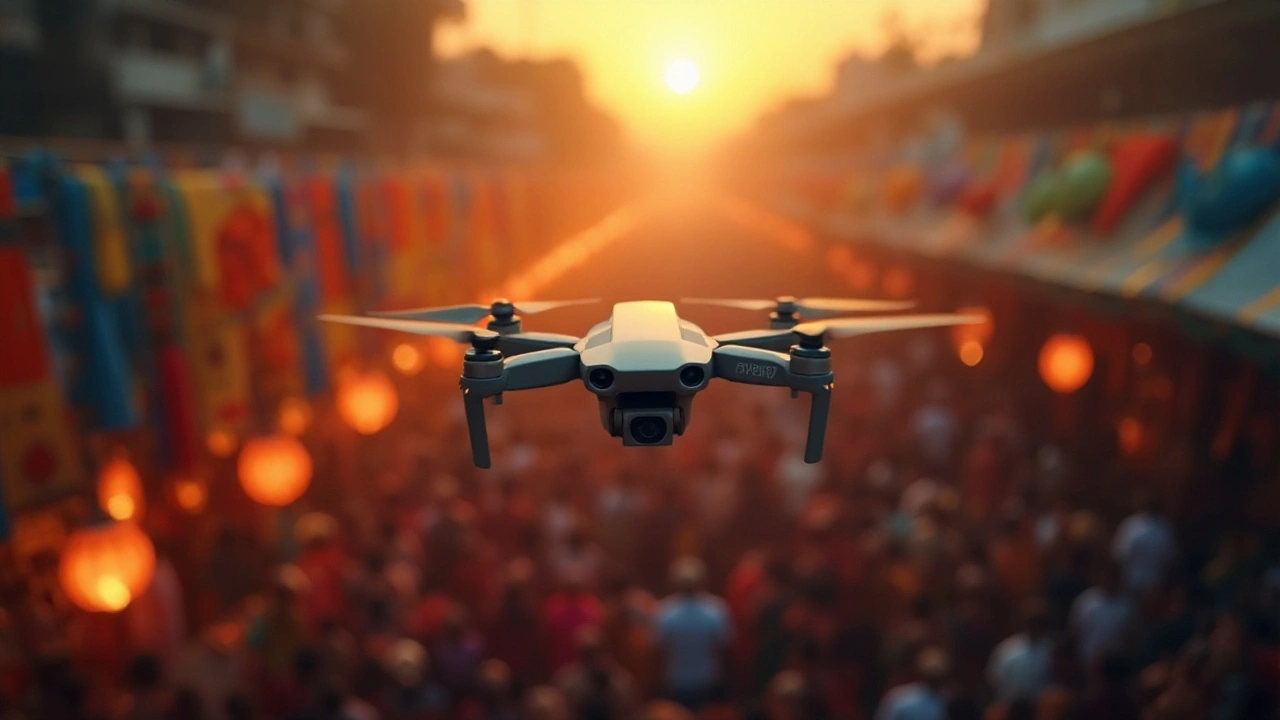
Tips for Safe and Legal Drone Flying
Flying your DJI Mini 3 Pro is exhilarating, but ensuring that you're flying safely and legally is crucial. Understanding the guidelines to keep your drone flights within the boundaries of the law can often make the difference between a seamless aerial photography session and a costly mishap. In India, specific regulations have been put in place by the Directorate General of Civil Aviation (DGCA) to ensure public safety and privacy. First and foremost, always register your drone on the Digital Sky Platform, which is mandatory for all drones over 250 grams. Although the DJI Mini 3 Pro falls within a category that might not always require extensive paperwork, keeping updated registration helps avoid unwanted penalties.
An essential aspect of safe flying is awareness of your surroundings. Even with a DJI Mini 3 Pro, which is equipped with advanced obstacle sensors, staying vigilant about where you're flying can prevent accidents. Always avoid dense residential areas, crowded places, or areas near an airport without proper permissions. Consider using a checklist to ensure your sessions cover all safety protocols. Also, routine checks of the drone's functions before a flight ensure fewer things go awry mid-air.
Respect airspace regulations and ensure you're not intruding into no-fly zones, which are available on maps provided by the DGCA. India has strict zones defined where aerial activities are prohibited. The altitude cap for drone flights is 400 feet above ground, and you should keep your drone within your visual line of sight. Educate yourself continuously on updates to these regulations. As technology evolves, so does the legislative landscape. Being proactive saves time and money.
For those planning to shoot commercially with their drones, obtaining necessary certifications is crucial. According to Swati Sharma, an aviation expert, "Commercial drone flying without a license can attract legal repercussions."
Documentation not only legitimizes your project but protects you against any infringements during your shoot.It is worth investing the time to go through practical training and becoming certified to mitigate risks during your drone operations.
Technical preparedness matches regulatory compliance. Ensure your DJI Mini 3 Pro is updated with the latest firmware. Software plays a crucial role in determining the range, image quality, and other functionalities of your drone, which are necessary for professional footage. Keeping spare batteries and a robust carrying case is essential as well, catering to extended sessions without interruptions. Emphasize battery health by following the manufacturer’s guidelines to prolong lifespan and avoid mid-air failures.
Finally, pilot etiquette cannot be overstated. Being courteous and respectful to people whose space or privacy may be impacted by your flying creates a positive atmosphere and reduces conflict. Public awareness of drones is increasing, so maintaining transparency in your activities helps bridge gaps with curious individuals. Demonstrating considerations such as these not only enhances your flying experience but also propagates a responsible culture for new enthusiasts entering the world of drone photography.
Future of Drone Usage in India
The sky’s the limit when it comes to the burgeoning field of drone technology in India. As the appetite for innovative technology grows, drones are poised to become an integral part of various sectors, from agriculture to entertainment. New advancements in drone capabilities and decreasing costs may soon make these flying devices a staple in both professional and personal landscapes. The government's support in regulating and integrating drones into different industries is pivotal, as technological adoption relies heavily on legal frameworks that encourage safe practices. As Indian skies open to commercial drone operations, potential applications are as vast as the sky above.
For agriculture, drones can transform traditional farming methods into precision-based practices, revolutionizing crop monitoring and management. With the ability to capture detailed aerial images, drones enable farmers to assess crop health and identify pest infestations early, leading to healthier and more bountiful harvests. In cinematography, drones are becoming the go-to device for filmmakers seeking dramatic aerial shots that were once only possible with expensive crane rigs or helicopters. The lightweight and versatile DJI Mini 3 Pro is especially attractive for creative professionals because it merges high quality with portability, ideal for both veteran filmmakers and budding videographers. This growing demand for drones in creative projects is pushing boundaries and setting new trends in visual storytelling.
Nonetheless, challenges remain, particularly regarding public perception and privacy concerns, which need addressing through thoughtful guidelines and education. The government is aware of this and has started implementing policy frameworks aimed at balancing innovation with public safety. According to the Ministry of Civil Aviation's Drone Policy, continuous updates are expected in the near future to streamline technology integration. Drone license requirements might evolve as drones become more ubiquitous, ensuring operators are trained adequately for their safe usage.
"The Drone Rules, 2021 have been formulated to enhance ease of business and transparency, while balancing safety and security considerations," said Jyotiraditya Scindia, Minister of Civil Aviation.
Enthusiasts and businesses should keep an eye on these developments, as adapting to regulatory changes can position them favorably in the market. Entrepreneurs are already leveraging drones for innovative services like logistics and delivery, which hold promise for densely populated cities where conventional delivery methods face roadblocks. The prospect of seeing drones deliver packages or even emergency medical supplies hovering above urban hubs in the near term is no longer just a futuristic fantasy, and indications suggest this utility will expand across various domains.
Ultimately, the trajectory of drone usage in India points towards greater integration, innovation, and adaptation, matching global trends while addressing domestic needs. With the right mix of technology, policy, and public awareness, drones stand to create new opportunities that were once unthinkable. For anyone involved in the drone sector, whether as a hobbyist or professional, staying abreast of the transforming landscape will be essential to successfully navigating what promises to be an exciting chapter in India’s technological evolution.
